Analyzing Social Media, ERP & Innovation in Business Computing
VerifiedAdded on 2023/03/21
|10
|3795
|71
Homework Assignment
AI Summary
This assignment delves into various aspects of business computing, starting with how social media has transformed communication, highlighting both its positive uses such as knowledge sharing and socialization, and negative effects like reduced research efforts. It then explores disruptive innovation using the example of 3D printing and its potential impact on industries. The assignment also identifies the five most used websites globally (Google, YouTube, Facebook, Wikipedia, and Yahoo) and discusses their utility. Furthermore, it touches upon the importance of up-to-date statistics, particularly internet usage data, and the value of knowledge sharing among classmates. Finally, it briefly addresses ERP implementation success factors and the accountability of algorithms against discrimination, questioning the bias of major social platforms.
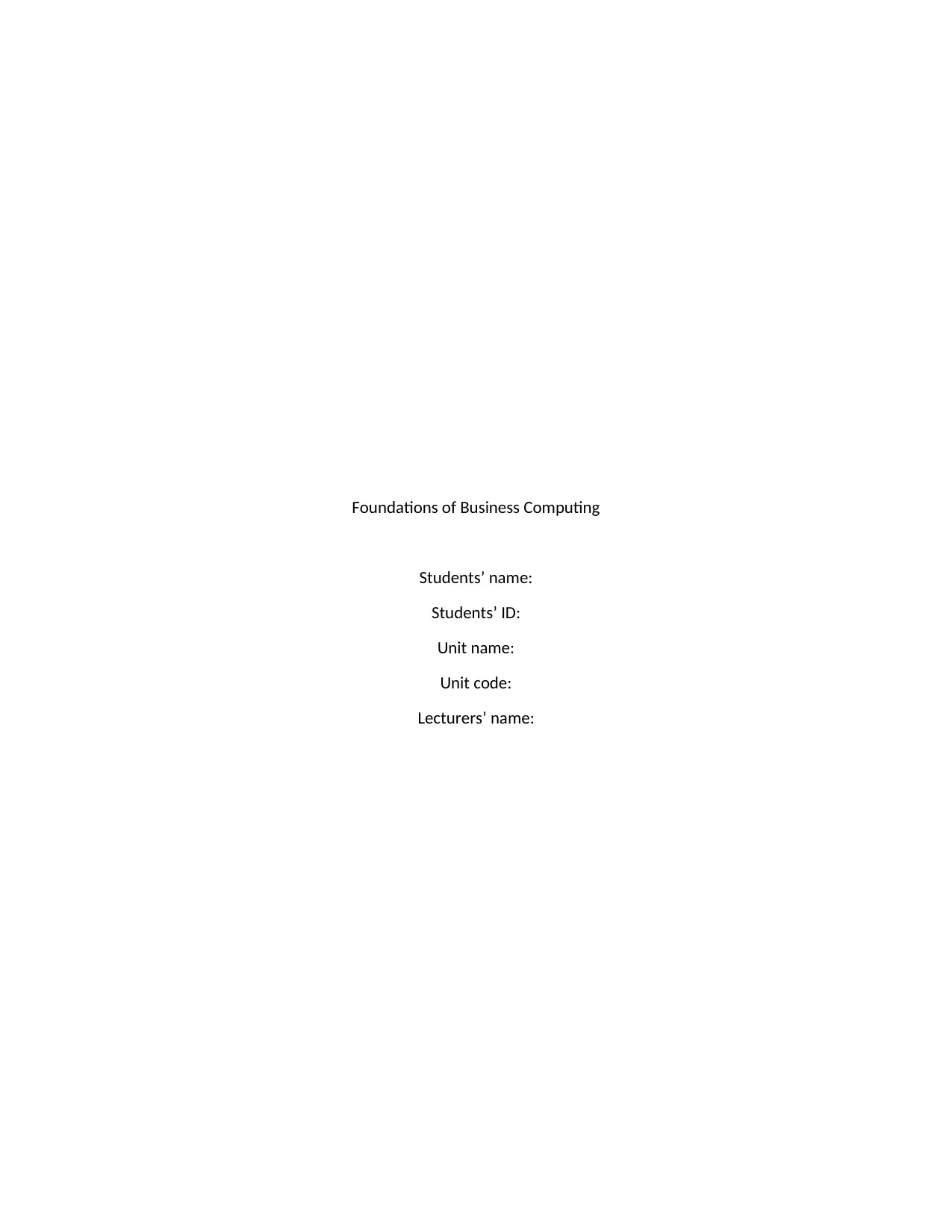
Foundations of Business Computing
Students’ name:
Students’ ID:
Unit name:
Unit code:
Lecturers’ name:
Students’ name:
Students’ ID:
Unit name:
Unit code:
Lecturers’ name:
Paraphrase This Document
Need a fresh take? Get an instant paraphrase of this document with our AI Paraphraser
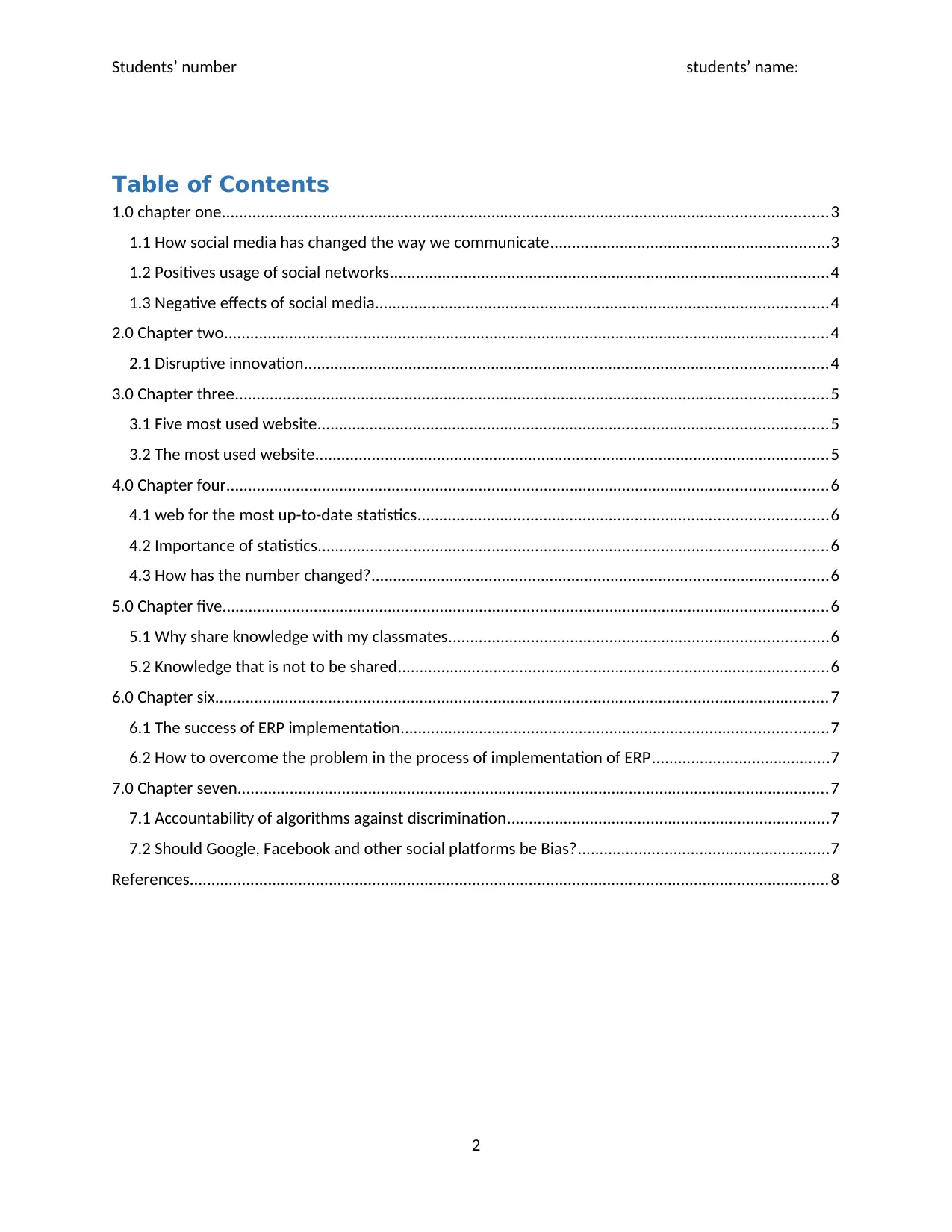
Students’ number students’ name:
Table of Contents
1.0 chapter one...........................................................................................................................................3
1.1 How social media has changed the way we communicate................................................................3
1.2 Positives usage of social networks.....................................................................................................4
1.3 Negative effects of social media........................................................................................................4
2.0 Chapter two...........................................................................................................................................4
2.1 Disruptive innovation........................................................................................................................4
3.0 Chapter three........................................................................................................................................5
3.1 Five most used website.....................................................................................................................5
3.2 The most used website......................................................................................................................5
4.0 Chapter four..........................................................................................................................................6
4.1 web for the most up-to-date statistics..............................................................................................6
4.2 Importance of statistics.....................................................................................................................6
4.3 How has the number changed?.........................................................................................................6
5.0 Chapter five...........................................................................................................................................6
5.1 Why share knowledge with my classmates.......................................................................................6
5.2 Knowledge that is not to be shared...................................................................................................6
6.0 Chapter six.............................................................................................................................................7
6.1 The success of ERP implementation..................................................................................................7
6.2 How to overcome the problem in the process of implementation of ERP.........................................7
7.0 Chapter seven........................................................................................................................................7
7.1 Accountability of algorithms against discrimination..........................................................................7
7.2 Should Google, Facebook and other social platforms be Bias?..........................................................7
References...................................................................................................................................................8
2
Table of Contents
1.0 chapter one...........................................................................................................................................3
1.1 How social media has changed the way we communicate................................................................3
1.2 Positives usage of social networks.....................................................................................................4
1.3 Negative effects of social media........................................................................................................4
2.0 Chapter two...........................................................................................................................................4
2.1 Disruptive innovation........................................................................................................................4
3.0 Chapter three........................................................................................................................................5
3.1 Five most used website.....................................................................................................................5
3.2 The most used website......................................................................................................................5
4.0 Chapter four..........................................................................................................................................6
4.1 web for the most up-to-date statistics..............................................................................................6
4.2 Importance of statistics.....................................................................................................................6
4.3 How has the number changed?.........................................................................................................6
5.0 Chapter five...........................................................................................................................................6
5.1 Why share knowledge with my classmates.......................................................................................6
5.2 Knowledge that is not to be shared...................................................................................................6
6.0 Chapter six.............................................................................................................................................7
6.1 The success of ERP implementation..................................................................................................7
6.2 How to overcome the problem in the process of implementation of ERP.........................................7
7.0 Chapter seven........................................................................................................................................7
7.1 Accountability of algorithms against discrimination..........................................................................7
7.2 Should Google, Facebook and other social platforms be Bias?..........................................................7
References...................................................................................................................................................8
2
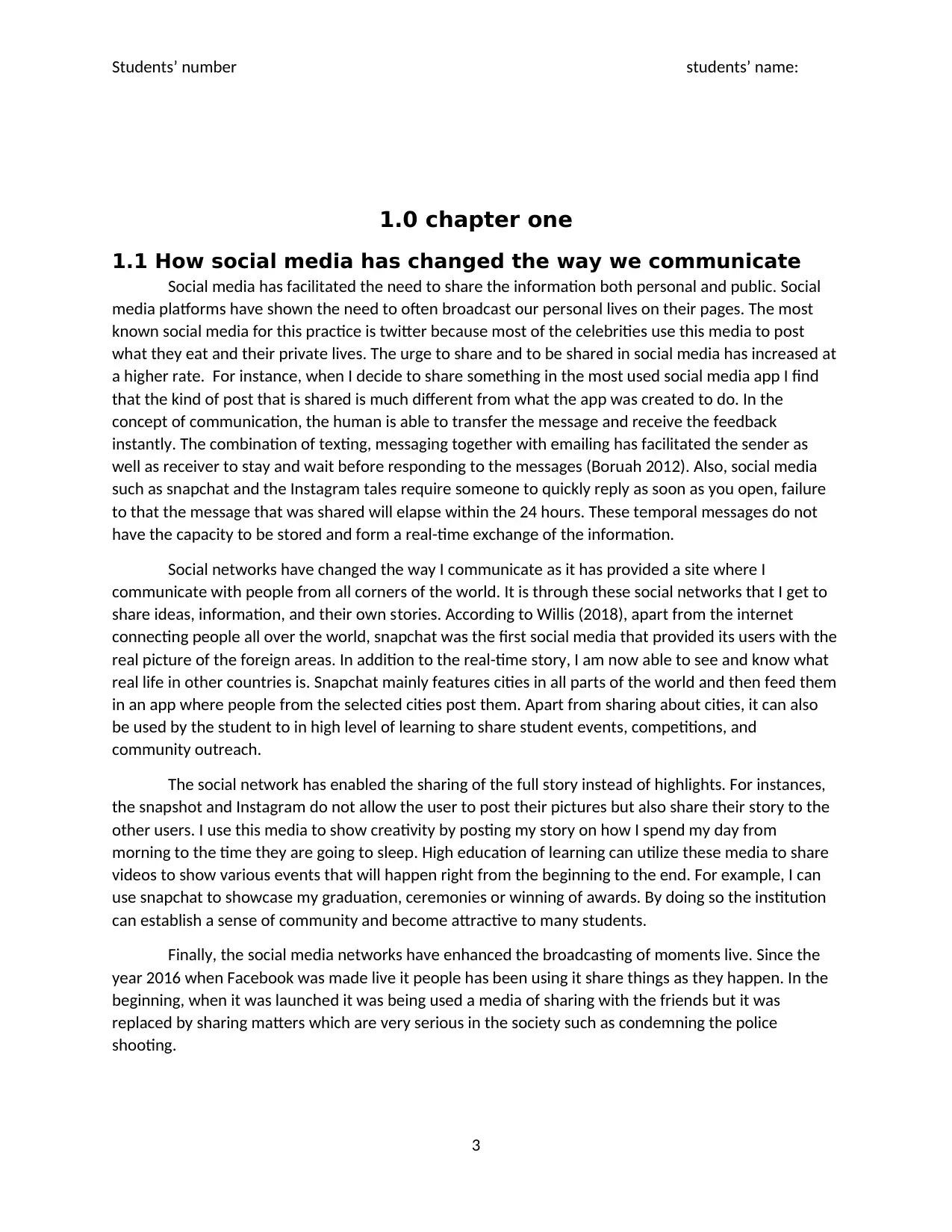
Students’ number students’ name:
1.0 chapter one
1.1 How social media has changed the way we communicate
Social media has facilitated the need to share the information both personal and public. Social
media platforms have shown the need to often broadcast our personal lives on their pages. The most
known social media for this practice is twitter because most of the celebrities use this media to post
what they eat and their private lives. The urge to share and to be shared in social media has increased at
a higher rate. For instance, when I decide to share something in the most used social media app I find
that the kind of post that is shared is much different from what the app was created to do. In the
concept of communication, the human is able to transfer the message and receive the feedback
instantly. The combination of texting, messaging together with emailing has facilitated the sender as
well as receiver to stay and wait before responding to the messages (Boruah 2012). Also, social media
such as snapchat and the Instagram tales require someone to quickly reply as soon as you open, failure
to that the message that was shared will elapse within the 24 hours. These temporal messages do not
have the capacity to be stored and form a real-time exchange of the information.
Social networks have changed the way I communicate as it has provided a site where I
communicate with people from all corners of the world. It is through these social networks that I get to
share ideas, information, and their own stories. According to Willis (2018), apart from the internet
connecting people all over the world, snapchat was the first social media that provided its users with the
real picture of the foreign areas. In addition to the real-time story, I am now able to see and know what
real life in other countries is. Snapchat mainly features cities in all parts of the world and then feed them
in an app where people from the selected cities post them. Apart from sharing about cities, it can also
be used by the student to in high level of learning to share student events, competitions, and
community outreach.
The social network has enabled the sharing of the full story instead of highlights. For instances,
the snapshot and Instagram do not allow the user to post their pictures but also share their story to the
other users. I use this media to show creativity by posting my story on how I spend my day from
morning to the time they are going to sleep. High education of learning can utilize these media to share
videos to show various events that will happen right from the beginning to the end. For example, I can
use snapchat to showcase my graduation, ceremonies or winning of awards. By doing so the institution
can establish a sense of community and become attractive to many students.
Finally, the social media networks have enhanced the broadcasting of moments live. Since the
year 2016 when Facebook was made live it people has been using it share things as they happen. In the
beginning, when it was launched it was being used a media of sharing with the friends but it was
replaced by sharing matters which are very serious in the society such as condemning the police
shooting.
3
1.0 chapter one
1.1 How social media has changed the way we communicate
Social media has facilitated the need to share the information both personal and public. Social
media platforms have shown the need to often broadcast our personal lives on their pages. The most
known social media for this practice is twitter because most of the celebrities use this media to post
what they eat and their private lives. The urge to share and to be shared in social media has increased at
a higher rate. For instance, when I decide to share something in the most used social media app I find
that the kind of post that is shared is much different from what the app was created to do. In the
concept of communication, the human is able to transfer the message and receive the feedback
instantly. The combination of texting, messaging together with emailing has facilitated the sender as
well as receiver to stay and wait before responding to the messages (Boruah 2012). Also, social media
such as snapchat and the Instagram tales require someone to quickly reply as soon as you open, failure
to that the message that was shared will elapse within the 24 hours. These temporal messages do not
have the capacity to be stored and form a real-time exchange of the information.
Social networks have changed the way I communicate as it has provided a site where I
communicate with people from all corners of the world. It is through these social networks that I get to
share ideas, information, and their own stories. According to Willis (2018), apart from the internet
connecting people all over the world, snapchat was the first social media that provided its users with the
real picture of the foreign areas. In addition to the real-time story, I am now able to see and know what
real life in other countries is. Snapchat mainly features cities in all parts of the world and then feed them
in an app where people from the selected cities post them. Apart from sharing about cities, it can also
be used by the student to in high level of learning to share student events, competitions, and
community outreach.
The social network has enabled the sharing of the full story instead of highlights. For instances,
the snapshot and Instagram do not allow the user to post their pictures but also share their story to the
other users. I use this media to show creativity by posting my story on how I spend my day from
morning to the time they are going to sleep. High education of learning can utilize these media to share
videos to show various events that will happen right from the beginning to the end. For example, I can
use snapchat to showcase my graduation, ceremonies or winning of awards. By doing so the institution
can establish a sense of community and become attractive to many students.
Finally, the social media networks have enhanced the broadcasting of moments live. Since the
year 2016 when Facebook was made live it people has been using it share things as they happen. In the
beginning, when it was launched it was being used a media of sharing with the friends but it was
replaced by sharing matters which are very serious in the society such as condemning the police
shooting.
3
⊘ This is a preview!⊘
Do you want full access?
Subscribe today to unlock all pages.

Trusted by 1+ million students worldwide
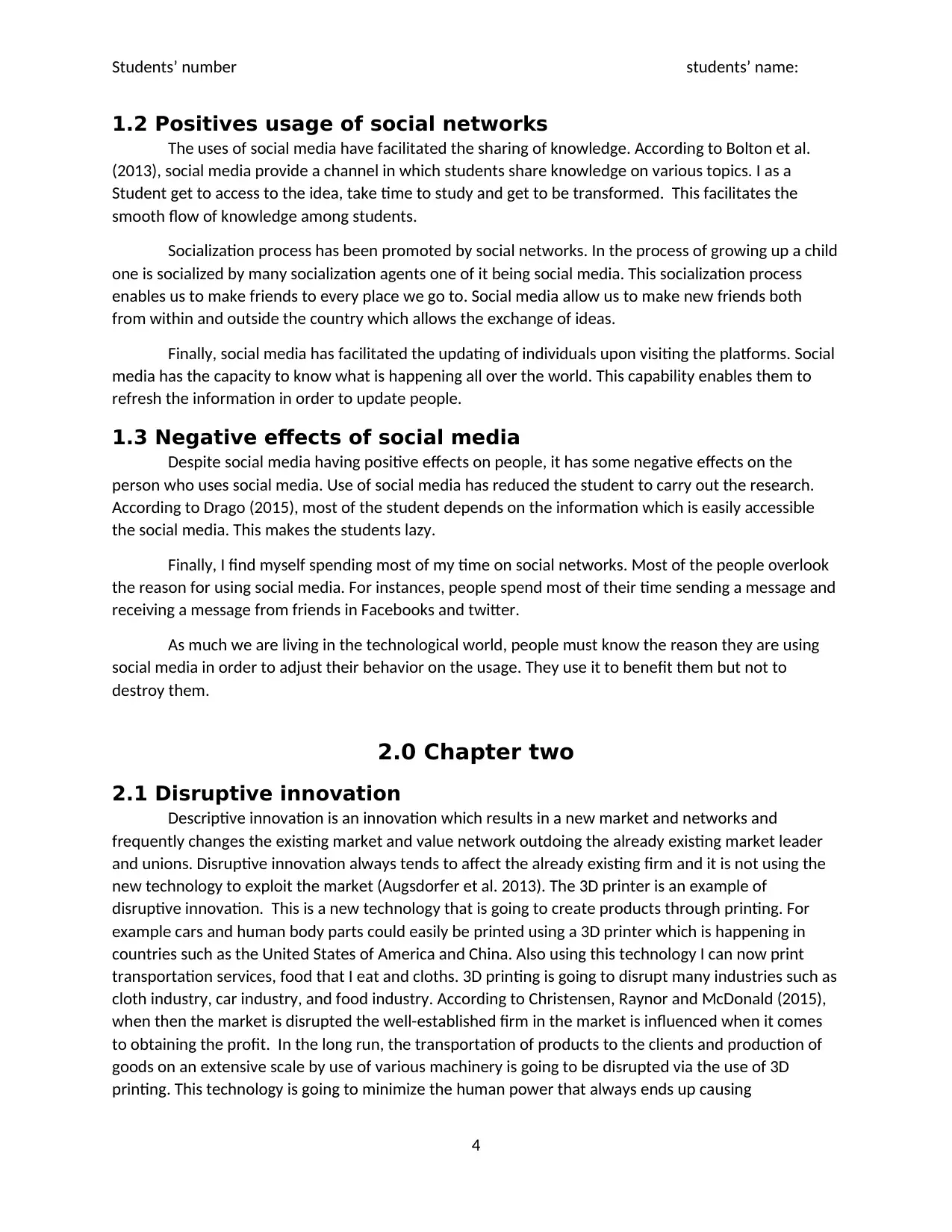
Students’ number students’ name:
1.2 Positives usage of social networks
The uses of social media have facilitated the sharing of knowledge. According to Bolton et al.
(2013), social media provide a channel in which students share knowledge on various topics. I as a
Student get to access to the idea, take time to study and get to be transformed. This facilitates the
smooth flow of knowledge among students.
Socialization process has been promoted by social networks. In the process of growing up a child
one is socialized by many socialization agents one of it being social media. This socialization process
enables us to make friends to every place we go to. Social media allow us to make new friends both
from within and outside the country which allows the exchange of ideas.
Finally, social media has facilitated the updating of individuals upon visiting the platforms. Social
media has the capacity to know what is happening all over the world. This capability enables them to
refresh the information in order to update people.
1.3 Negative effects of social media
Despite social media having positive effects on people, it has some negative effects on the
person who uses social media. Use of social media has reduced the student to carry out the research.
According to Drago (2015), most of the student depends on the information which is easily accessible
the social media. This makes the students lazy.
Finally, I find myself spending most of my time on social networks. Most of the people overlook
the reason for using social media. For instances, people spend most of their time sending a message and
receiving a message from friends in Facebooks and twitter.
As much we are living in the technological world, people must know the reason they are using
social media in order to adjust their behavior on the usage. They use it to benefit them but not to
destroy them.
2.0 Chapter two
2.1 Disruptive innovation
Descriptive innovation is an innovation which results in a new market and networks and
frequently changes the existing market and value network outdoing the already existing market leader
and unions. Disruptive innovation always tends to affect the already existing firm and it is not using the
new technology to exploit the market (Augsdorfer et al. 2013). The 3D printer is an example of
disruptive innovation. This is a new technology that is going to create products through printing. For
example cars and human body parts could easily be printed using a 3D printer which is happening in
countries such as the United States of America and China. Also using this technology I can now print
transportation services, food that I eat and cloths. 3D printing is going to disrupt many industries such as
cloth industry, car industry, and food industry. According to Christensen, Raynor and McDonald (2015),
when then the market is disrupted the well-established firm in the market is influenced when it comes
to obtaining the profit. In the long run, the transportation of products to the clients and production of
goods on an extensive scale by use of various machinery is going to be disrupted via the use of 3D
printing. This technology is going to minimize the human power that always ends up causing
4
1.2 Positives usage of social networks
The uses of social media have facilitated the sharing of knowledge. According to Bolton et al.
(2013), social media provide a channel in which students share knowledge on various topics. I as a
Student get to access to the idea, take time to study and get to be transformed. This facilitates the
smooth flow of knowledge among students.
Socialization process has been promoted by social networks. In the process of growing up a child
one is socialized by many socialization agents one of it being social media. This socialization process
enables us to make friends to every place we go to. Social media allow us to make new friends both
from within and outside the country which allows the exchange of ideas.
Finally, social media has facilitated the updating of individuals upon visiting the platforms. Social
media has the capacity to know what is happening all over the world. This capability enables them to
refresh the information in order to update people.
1.3 Negative effects of social media
Despite social media having positive effects on people, it has some negative effects on the
person who uses social media. Use of social media has reduced the student to carry out the research.
According to Drago (2015), most of the student depends on the information which is easily accessible
the social media. This makes the students lazy.
Finally, I find myself spending most of my time on social networks. Most of the people overlook
the reason for using social media. For instances, people spend most of their time sending a message and
receiving a message from friends in Facebooks and twitter.
As much we are living in the technological world, people must know the reason they are using
social media in order to adjust their behavior on the usage. They use it to benefit them but not to
destroy them.
2.0 Chapter two
2.1 Disruptive innovation
Descriptive innovation is an innovation which results in a new market and networks and
frequently changes the existing market and value network outdoing the already existing market leader
and unions. Disruptive innovation always tends to affect the already existing firm and it is not using the
new technology to exploit the market (Augsdorfer et al. 2013). The 3D printer is an example of
disruptive innovation. This is a new technology that is going to create products through printing. For
example cars and human body parts could easily be printed using a 3D printer which is happening in
countries such as the United States of America and China. Also using this technology I can now print
transportation services, food that I eat and cloths. 3D printing is going to disrupt many industries such as
cloth industry, car industry, and food industry. According to Christensen, Raynor and McDonald (2015),
when then the market is disrupted the well-established firm in the market is influenced when it comes
to obtaining the profit. In the long run, the transportation of products to the clients and production of
goods on an extensive scale by use of various machinery is going to be disrupted via the use of 3D
printing. This technology is going to minimize the human power that always ends up causing
4
Paraphrase This Document
Need a fresh take? Get an instant paraphrase of this document with our AI Paraphraser
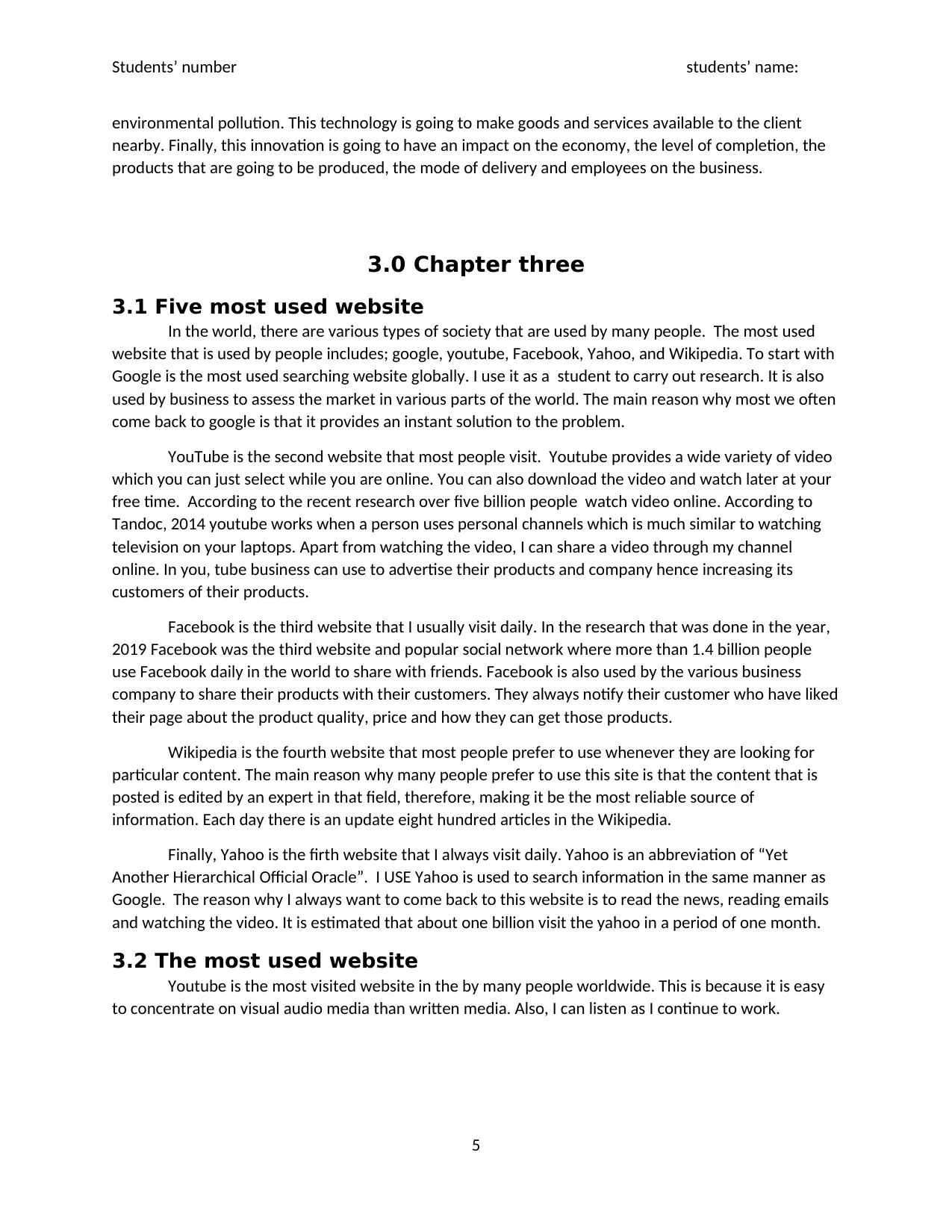
Students’ number students’ name:
environmental pollution. This technology is going to make goods and services available to the client
nearby. Finally, this innovation is going to have an impact on the economy, the level of completion, the
products that are going to be produced, the mode of delivery and employees on the business.
3.0 Chapter three
3.1 Five most used website
In the world, there are various types of society that are used by many people. The most used
website that is used by people includes; google, youtube, Facebook, Yahoo, and Wikipedia. To start with
Google is the most used searching website globally. I use it as a student to carry out research. It is also
used by business to assess the market in various parts of the world. The main reason why most we often
come back to google is that it provides an instant solution to the problem.
YouTube is the second website that most people visit. Youtube provides a wide variety of video
which you can just select while you are online. You can also download the video and watch later at your
free time. According to the recent research over five billion people watch video online. According to
Tandoc, 2014 youtube works when a person uses personal channels which is much similar to watching
television on your laptops. Apart from watching the video, I can share a video through my channel
online. In you, tube business can use to advertise their products and company hence increasing its
customers of their products.
Facebook is the third website that I usually visit daily. In the research that was done in the year,
2019 Facebook was the third website and popular social network where more than 1.4 billion people
use Facebook daily in the world to share with friends. Facebook is also used by the various business
company to share their products with their customers. They always notify their customer who have liked
their page about the product quality, price and how they can get those products.
Wikipedia is the fourth website that most people prefer to use whenever they are looking for
particular content. The main reason why many people prefer to use this site is that the content that is
posted is edited by an expert in that field, therefore, making it be the most reliable source of
information. Each day there is an update eight hundred articles in the Wikipedia.
Finally, Yahoo is the firth website that I always visit daily. Yahoo is an abbreviation of “Yet
Another Hierarchical Official Oracle”. I USE Yahoo is used to search information in the same manner as
Google. The reason why I always want to come back to this website is to read the news, reading emails
and watching the video. It is estimated that about one billion visit the yahoo in a period of one month.
3.2 The most used website
Youtube is the most visited website in the by many people worldwide. This is because it is easy
to concentrate on visual audio media than written media. Also, I can listen as I continue to work.
5
environmental pollution. This technology is going to make goods and services available to the client
nearby. Finally, this innovation is going to have an impact on the economy, the level of completion, the
products that are going to be produced, the mode of delivery and employees on the business.
3.0 Chapter three
3.1 Five most used website
In the world, there are various types of society that are used by many people. The most used
website that is used by people includes; google, youtube, Facebook, Yahoo, and Wikipedia. To start with
Google is the most used searching website globally. I use it as a student to carry out research. It is also
used by business to assess the market in various parts of the world. The main reason why most we often
come back to google is that it provides an instant solution to the problem.
YouTube is the second website that most people visit. Youtube provides a wide variety of video
which you can just select while you are online. You can also download the video and watch later at your
free time. According to the recent research over five billion people watch video online. According to
Tandoc, 2014 youtube works when a person uses personal channels which is much similar to watching
television on your laptops. Apart from watching the video, I can share a video through my channel
online. In you, tube business can use to advertise their products and company hence increasing its
customers of their products.
Facebook is the third website that I usually visit daily. In the research that was done in the year,
2019 Facebook was the third website and popular social network where more than 1.4 billion people
use Facebook daily in the world to share with friends. Facebook is also used by the various business
company to share their products with their customers. They always notify their customer who have liked
their page about the product quality, price and how they can get those products.
Wikipedia is the fourth website that most people prefer to use whenever they are looking for
particular content. The main reason why many people prefer to use this site is that the content that is
posted is edited by an expert in that field, therefore, making it be the most reliable source of
information. Each day there is an update eight hundred articles in the Wikipedia.
Finally, Yahoo is the firth website that I always visit daily. Yahoo is an abbreviation of “Yet
Another Hierarchical Official Oracle”. I USE Yahoo is used to search information in the same manner as
Google. The reason why I always want to come back to this website is to read the news, reading emails
and watching the video. It is estimated that about one billion visit the yahoo in a period of one month.
3.2 The most used website
Youtube is the most visited website in the by many people worldwide. This is because it is easy
to concentrate on visual audio media than written media. Also, I can listen as I continue to work.
5
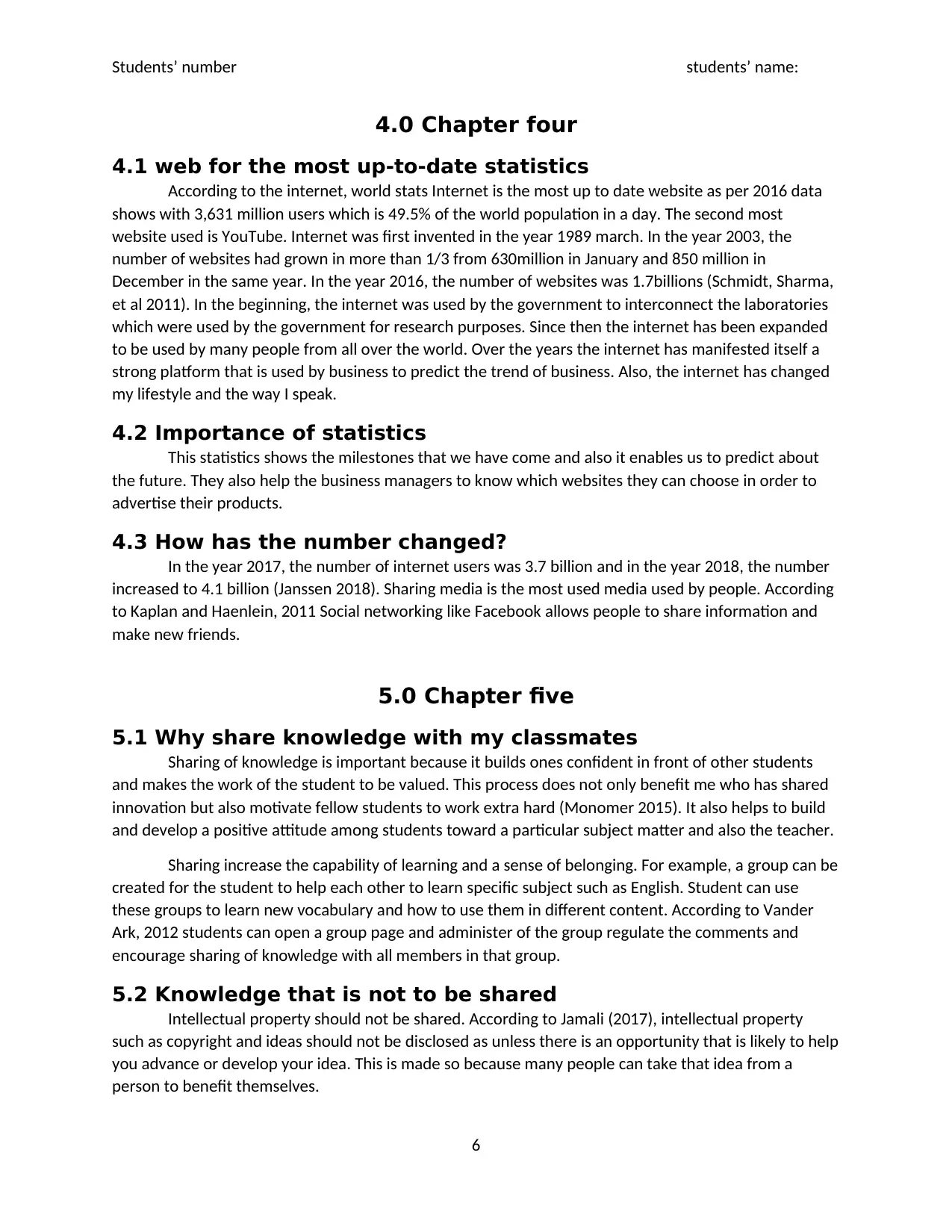
Students’ number students’ name:
4.0 Chapter four
4.1 web for the most up-to-date statistics
According to the internet, world stats Internet is the most up to date website as per 2016 data
shows with 3,631 million users which is 49.5% of the world population in a day. The second most
website used is YouTube. Internet was first invented in the year 1989 march. In the year 2003, the
number of websites had grown in more than 1/3 from 630million in January and 850 million in
December in the same year. In the year 2016, the number of websites was 1.7billions (Schmidt, Sharma,
et al 2011). In the beginning, the internet was used by the government to interconnect the laboratories
which were used by the government for research purposes. Since then the internet has been expanded
to be used by many people from all over the world. Over the years the internet has manifested itself a
strong platform that is used by business to predict the trend of business. Also, the internet has changed
my lifestyle and the way I speak.
4.2 Importance of statistics
This statistics shows the milestones that we have come and also it enables us to predict about
the future. They also help the business managers to know which websites they can choose in order to
advertise their products.
4.3 How has the number changed?
In the year 2017, the number of internet users was 3.7 billion and in the year 2018, the number
increased to 4.1 billion (Janssen 2018). Sharing media is the most used media used by people. According
to Kaplan and Haenlein, 2011 Social networking like Facebook allows people to share information and
make new friends.
5.0 Chapter five
5.1 Why share knowledge with my classmates
Sharing of knowledge is important because it builds ones confident in front of other students
and makes the work of the student to be valued. This process does not only benefit me who has shared
innovation but also motivate fellow students to work extra hard (Monomer 2015). It also helps to build
and develop a positive attitude among students toward a particular subject matter and also the teacher.
Sharing increase the capability of learning and a sense of belonging. For example, a group can be
created for the student to help each other to learn specific subject such as English. Student can use
these groups to learn new vocabulary and how to use them in different content. According to Vander
Ark, 2012 students can open a group page and administer of the group regulate the comments and
encourage sharing of knowledge with all members in that group.
5.2 Knowledge that is not to be shared
Intellectual property should not be shared. According to Jamali (2017), intellectual property
such as copyright and ideas should not be disclosed as unless there is an opportunity that is likely to help
you advance or develop your idea. This is made so because many people can take that idea from a
person to benefit themselves.
6
4.0 Chapter four
4.1 web for the most up-to-date statistics
According to the internet, world stats Internet is the most up to date website as per 2016 data
shows with 3,631 million users which is 49.5% of the world population in a day. The second most
website used is YouTube. Internet was first invented in the year 1989 march. In the year 2003, the
number of websites had grown in more than 1/3 from 630million in January and 850 million in
December in the same year. In the year 2016, the number of websites was 1.7billions (Schmidt, Sharma,
et al 2011). In the beginning, the internet was used by the government to interconnect the laboratories
which were used by the government for research purposes. Since then the internet has been expanded
to be used by many people from all over the world. Over the years the internet has manifested itself a
strong platform that is used by business to predict the trend of business. Also, the internet has changed
my lifestyle and the way I speak.
4.2 Importance of statistics
This statistics shows the milestones that we have come and also it enables us to predict about
the future. They also help the business managers to know which websites they can choose in order to
advertise their products.
4.3 How has the number changed?
In the year 2017, the number of internet users was 3.7 billion and in the year 2018, the number
increased to 4.1 billion (Janssen 2018). Sharing media is the most used media used by people. According
to Kaplan and Haenlein, 2011 Social networking like Facebook allows people to share information and
make new friends.
5.0 Chapter five
5.1 Why share knowledge with my classmates
Sharing of knowledge is important because it builds ones confident in front of other students
and makes the work of the student to be valued. This process does not only benefit me who has shared
innovation but also motivate fellow students to work extra hard (Monomer 2015). It also helps to build
and develop a positive attitude among students toward a particular subject matter and also the teacher.
Sharing increase the capability of learning and a sense of belonging. For example, a group can be
created for the student to help each other to learn specific subject such as English. Student can use
these groups to learn new vocabulary and how to use them in different content. According to Vander
Ark, 2012 students can open a group page and administer of the group regulate the comments and
encourage sharing of knowledge with all members in that group.
5.2 Knowledge that is not to be shared
Intellectual property should not be shared. According to Jamali (2017), intellectual property
such as copyright and ideas should not be disclosed as unless there is an opportunity that is likely to help
you advance or develop your idea. This is made so because many people can take that idea from a
person to benefit themselves.
6
⊘ This is a preview!⊘
Do you want full access?
Subscribe today to unlock all pages.

Trusted by 1+ million students worldwide
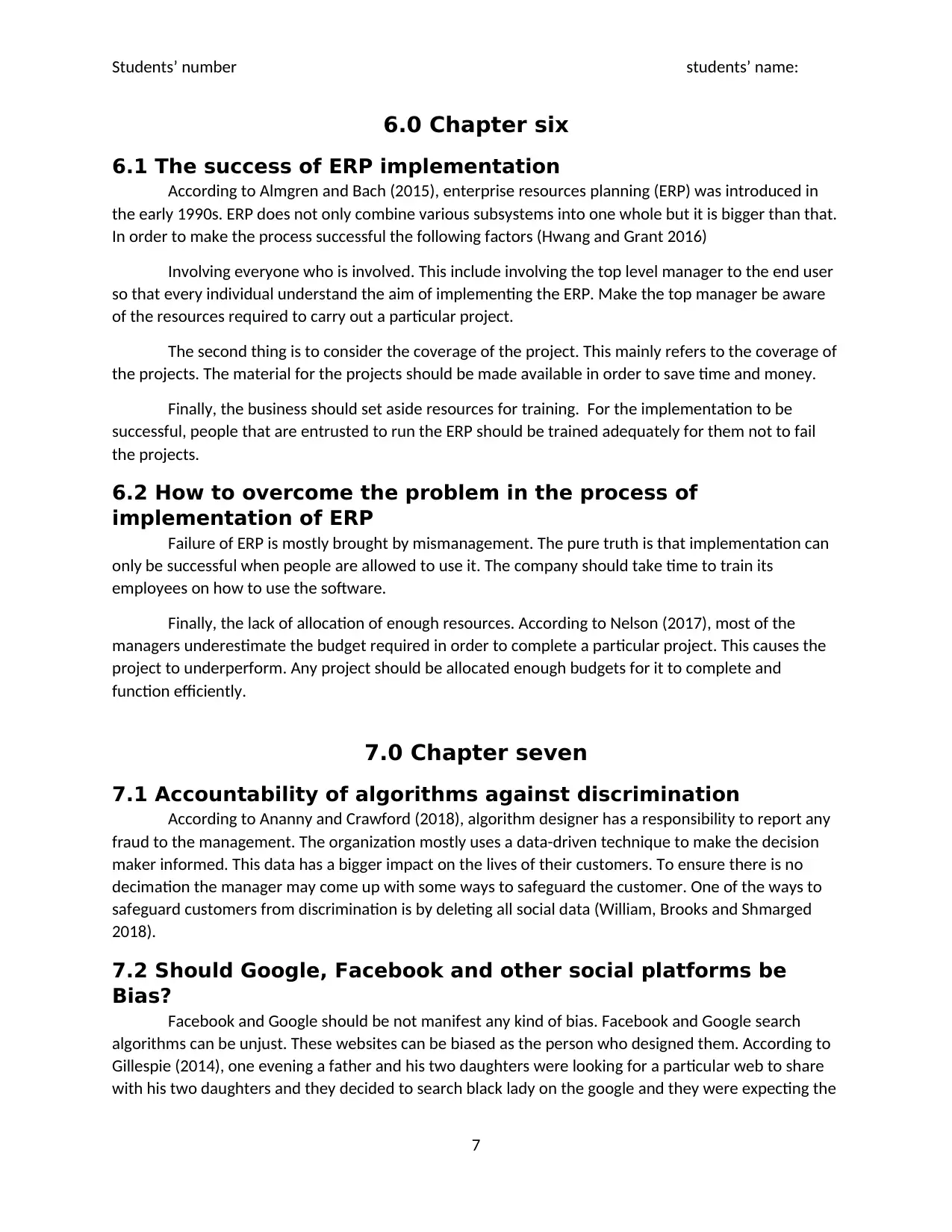
Students’ number students’ name:
6.0 Chapter six
6.1 The success of ERP implementation
According to Almgren and Bach (2015), enterprise resources planning (ERP) was introduced in
the early 1990s. ERP does not only combine various subsystems into one whole but it is bigger than that.
In order to make the process successful the following factors (Hwang and Grant 2016)
Involving everyone who is involved. This include involving the top level manager to the end user
so that every individual understand the aim of implementing the ERP. Make the top manager be aware
of the resources required to carry out a particular project.
The second thing is to consider the coverage of the project. This mainly refers to the coverage of
the projects. The material for the projects should be made available in order to save time and money.
Finally, the business should set aside resources for training. For the implementation to be
successful, people that are entrusted to run the ERP should be trained adequately for them not to fail
the projects.
6.2 How to overcome the problem in the process of
implementation of ERP
Failure of ERP is mostly brought by mismanagement. The pure truth is that implementation can
only be successful when people are allowed to use it. The company should take time to train its
employees on how to use the software.
Finally, the lack of allocation of enough resources. According to Nelson (2017), most of the
managers underestimate the budget required in order to complete a particular project. This causes the
project to underperform. Any project should be allocated enough budgets for it to complete and
function efficiently.
7.0 Chapter seven
7.1 Accountability of algorithms against discrimination
According to Ananny and Crawford (2018), algorithm designer has a responsibility to report any
fraud to the management. The organization mostly uses a data-driven technique to make the decision
maker informed. This data has a bigger impact on the lives of their customers. To ensure there is no
decimation the manager may come up with some ways to safeguard the customer. One of the ways to
safeguard customers from discrimination is by deleting all social data (William, Brooks and Shmarged
2018).
7.2 Should Google, Facebook and other social platforms be
Bias?
Facebook and Google should be not manifest any kind of bias. Facebook and Google search
algorithms can be unjust. These websites can be biased as the person who designed them. According to
Gillespie (2014), one evening a father and his two daughters were looking for a particular web to share
with his two daughters and they decided to search black lady on the google and they were expecting the
7
6.0 Chapter six
6.1 The success of ERP implementation
According to Almgren and Bach (2015), enterprise resources planning (ERP) was introduced in
the early 1990s. ERP does not only combine various subsystems into one whole but it is bigger than that.
In order to make the process successful the following factors (Hwang and Grant 2016)
Involving everyone who is involved. This include involving the top level manager to the end user
so that every individual understand the aim of implementing the ERP. Make the top manager be aware
of the resources required to carry out a particular project.
The second thing is to consider the coverage of the project. This mainly refers to the coverage of
the projects. The material for the projects should be made available in order to save time and money.
Finally, the business should set aside resources for training. For the implementation to be
successful, people that are entrusted to run the ERP should be trained adequately for them not to fail
the projects.
6.2 How to overcome the problem in the process of
implementation of ERP
Failure of ERP is mostly brought by mismanagement. The pure truth is that implementation can
only be successful when people are allowed to use it. The company should take time to train its
employees on how to use the software.
Finally, the lack of allocation of enough resources. According to Nelson (2017), most of the
managers underestimate the budget required in order to complete a particular project. This causes the
project to underperform. Any project should be allocated enough budgets for it to complete and
function efficiently.
7.0 Chapter seven
7.1 Accountability of algorithms against discrimination
According to Ananny and Crawford (2018), algorithm designer has a responsibility to report any
fraud to the management. The organization mostly uses a data-driven technique to make the decision
maker informed. This data has a bigger impact on the lives of their customers. To ensure there is no
decimation the manager may come up with some ways to safeguard the customer. One of the ways to
safeguard customers from discrimination is by deleting all social data (William, Brooks and Shmarged
2018).
7.2 Should Google, Facebook and other social platforms be
Bias?
Facebook and Google should be not manifest any kind of bias. Facebook and Google search
algorithms can be unjust. These websites can be biased as the person who designed them. According to
Gillespie (2014), one evening a father and his two daughters were looking for a particular web to share
with his two daughters and they decided to search black lady on the google and they were expecting the
7
Paraphrase This Document
Need a fresh take? Get an instant paraphrase of this document with our AI Paraphraser
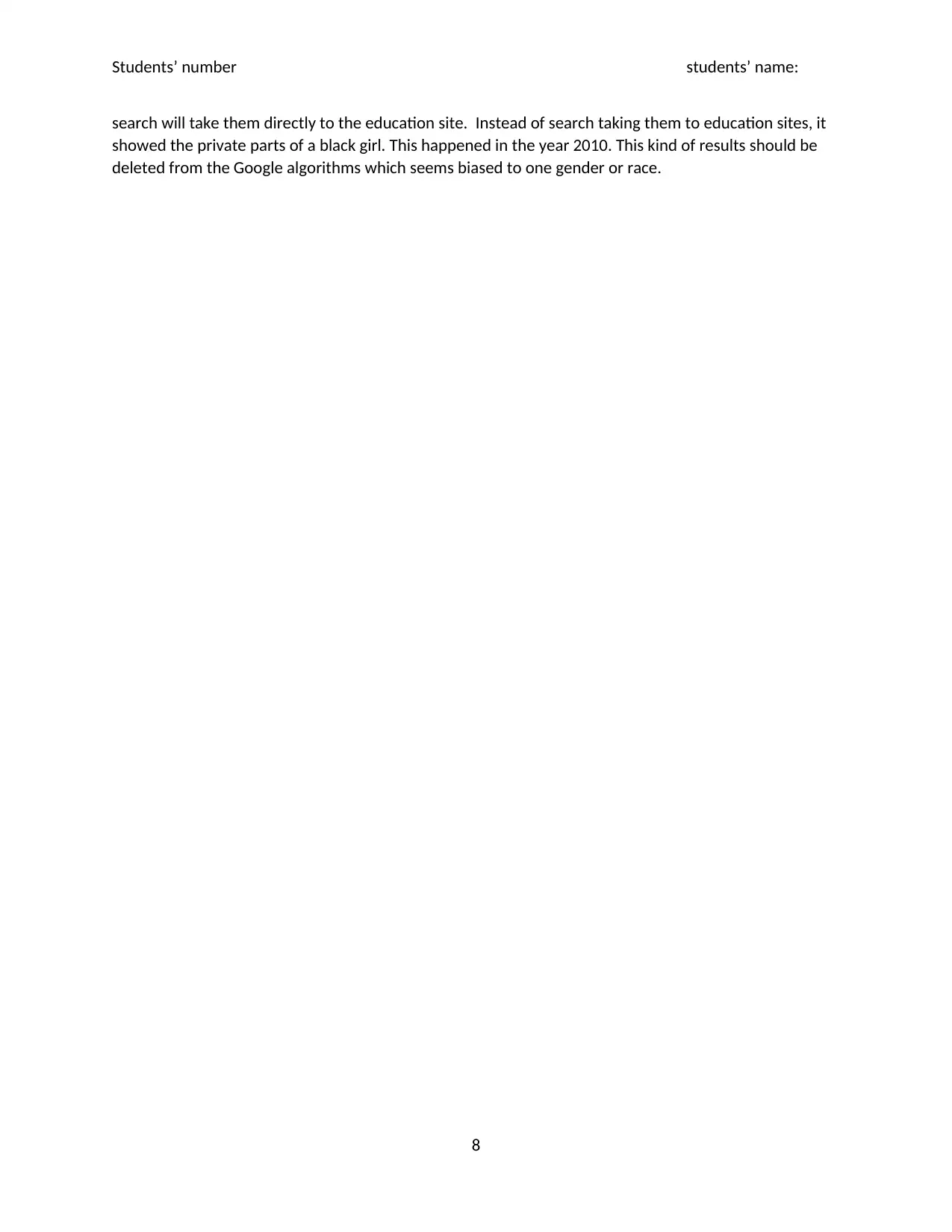
Students’ number students’ name:
search will take them directly to the education site. Instead of search taking them to education sites, it
showed the private parts of a black girl. This happened in the year 2010. This kind of results should be
deleted from the Google algorithms which seems biased to one gender or race.
8
search will take them directly to the education site. Instead of search taking them to education sites, it
showed the private parts of a black girl. This happened in the year 2010. This kind of results should be
deleted from the Google algorithms which seems biased to one gender or race.
8
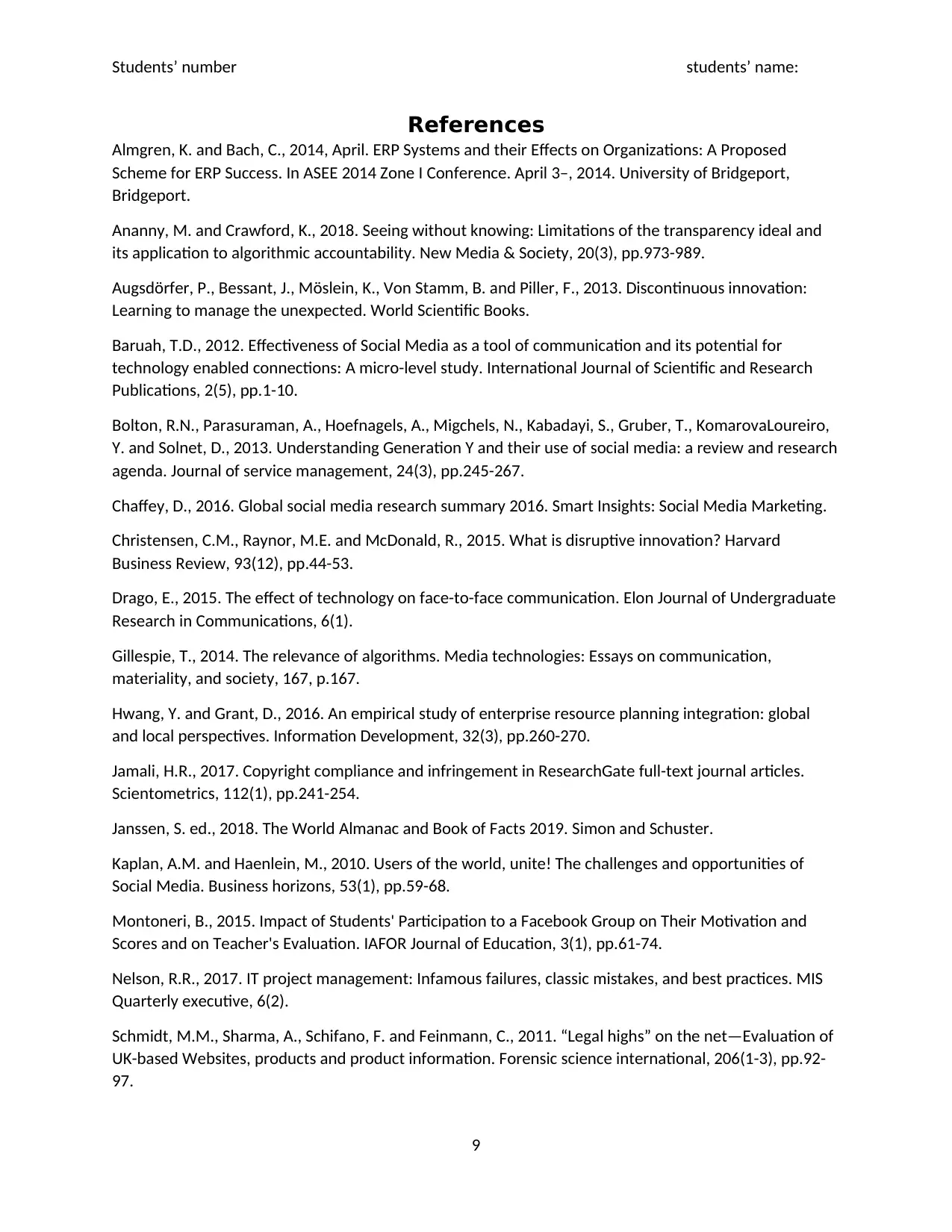
Students’ number students’ name:
References
Almgren, K. and Bach, C., 2014, April. ERP Systems and their Effects on Organizations: A Proposed
Scheme for ERP Success. In ASEE 2014 Zone I Conference. April 3–, 2014. University of Bridgeport,
Bridgeport.
Ananny, M. and Crawford, K., 2018. Seeing without knowing: Limitations of the transparency ideal and
its application to algorithmic accountability. New Media & Society, 20(3), pp.973-989.
Augsdörfer, P., Bessant, J., Möslein, K., Von Stamm, B. and Piller, F., 2013. Discontinuous innovation:
Learning to manage the unexpected. World Scientific Books.
Baruah, T.D., 2012. Effectiveness of Social Media as a tool of communication and its potential for
technology enabled connections: A micro-level study. International Journal of Scientific and Research
Publications, 2(5), pp.1-10.
Bolton, R.N., Parasuraman, A., Hoefnagels, A., Migchels, N., Kabadayi, S., Gruber, T., KomarovaLoureiro,
Y. and Solnet, D., 2013. Understanding Generation Y and their use of social media: a review and research
agenda. Journal of service management, 24(3), pp.245-267.
Chaffey, D., 2016. Global social media research summary 2016. Smart Insights: Social Media Marketing.
Christensen, C.M., Raynor, M.E. and McDonald, R., 2015. What is disruptive innovation? Harvard
Business Review, 93(12), pp.44-53.
Drago, E., 2015. The effect of technology on face-to-face communication. Elon Journal of Undergraduate
Research in Communications, 6(1).
Gillespie, T., 2014. The relevance of algorithms. Media technologies: Essays on communication,
materiality, and society, 167, p.167.
Hwang, Y. and Grant, D., 2016. An empirical study of enterprise resource planning integration: global
and local perspectives. Information Development, 32(3), pp.260-270.
Jamali, H.R., 2017. Copyright compliance and infringement in ResearchGate full-text journal articles.
Scientometrics, 112(1), pp.241-254.
Janssen, S. ed., 2018. The World Almanac and Book of Facts 2019. Simon and Schuster.
Kaplan, A.M. and Haenlein, M., 2010. Users of the world, unite! The challenges and opportunities of
Social Media. Business horizons, 53(1), pp.59-68.
Montoneri, B., 2015. Impact of Students' Participation to a Facebook Group on Their Motivation and
Scores and on Teacher's Evaluation. IAFOR Journal of Education, 3(1), pp.61-74.
Nelson, R.R., 2017. IT project management: Infamous failures, classic mistakes, and best practices. MIS
Quarterly executive, 6(2).
Schmidt, M.M., Sharma, A., Schifano, F. and Feinmann, C., 2011. “Legal highs” on the net—Evaluation of
UK-based Websites, products and product information. Forensic science international, 206(1-3), pp.92-
97.
9
References
Almgren, K. and Bach, C., 2014, April. ERP Systems and their Effects on Organizations: A Proposed
Scheme for ERP Success. In ASEE 2014 Zone I Conference. April 3–, 2014. University of Bridgeport,
Bridgeport.
Ananny, M. and Crawford, K., 2018. Seeing without knowing: Limitations of the transparency ideal and
its application to algorithmic accountability. New Media & Society, 20(3), pp.973-989.
Augsdörfer, P., Bessant, J., Möslein, K., Von Stamm, B. and Piller, F., 2013. Discontinuous innovation:
Learning to manage the unexpected. World Scientific Books.
Baruah, T.D., 2012. Effectiveness of Social Media as a tool of communication and its potential for
technology enabled connections: A micro-level study. International Journal of Scientific and Research
Publications, 2(5), pp.1-10.
Bolton, R.N., Parasuraman, A., Hoefnagels, A., Migchels, N., Kabadayi, S., Gruber, T., KomarovaLoureiro,
Y. and Solnet, D., 2013. Understanding Generation Y and their use of social media: a review and research
agenda. Journal of service management, 24(3), pp.245-267.
Chaffey, D., 2016. Global social media research summary 2016. Smart Insights: Social Media Marketing.
Christensen, C.M., Raynor, M.E. and McDonald, R., 2015. What is disruptive innovation? Harvard
Business Review, 93(12), pp.44-53.
Drago, E., 2015. The effect of technology on face-to-face communication. Elon Journal of Undergraduate
Research in Communications, 6(1).
Gillespie, T., 2014. The relevance of algorithms. Media technologies: Essays on communication,
materiality, and society, 167, p.167.
Hwang, Y. and Grant, D., 2016. An empirical study of enterprise resource planning integration: global
and local perspectives. Information Development, 32(3), pp.260-270.
Jamali, H.R., 2017. Copyright compliance and infringement in ResearchGate full-text journal articles.
Scientometrics, 112(1), pp.241-254.
Janssen, S. ed., 2018. The World Almanac and Book of Facts 2019. Simon and Schuster.
Kaplan, A.M. and Haenlein, M., 2010. Users of the world, unite! The challenges and opportunities of
Social Media. Business horizons, 53(1), pp.59-68.
Montoneri, B., 2015. Impact of Students' Participation to a Facebook Group on Their Motivation and
Scores and on Teacher's Evaluation. IAFOR Journal of Education, 3(1), pp.61-74.
Nelson, R.R., 2017. IT project management: Infamous failures, classic mistakes, and best practices. MIS
Quarterly executive, 6(2).
Schmidt, M.M., Sharma, A., Schifano, F. and Feinmann, C., 2011. “Legal highs” on the net—Evaluation of
UK-based Websites, products and product information. Forensic science international, 206(1-3), pp.92-
97.
9
⊘ This is a preview!⊘
Do you want full access?
Subscribe today to unlock all pages.

Trusted by 1+ million students worldwide
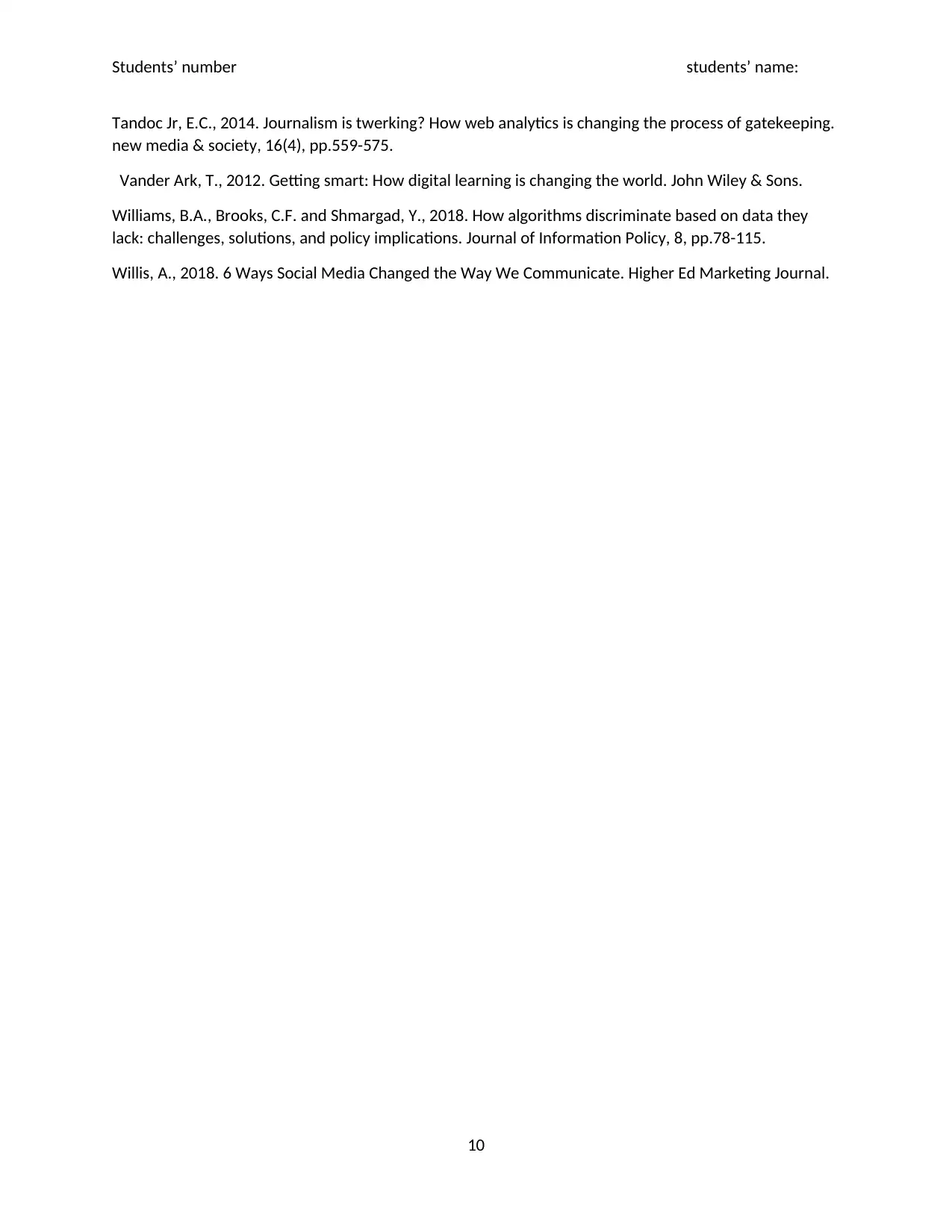
Students’ number students’ name:
Tandoc Jr, E.C., 2014. Journalism is twerking? How web analytics is changing the process of gatekeeping.
new media & society, 16(4), pp.559-575.
Vander Ark, T., 2012. Getting smart: How digital learning is changing the world. John Wiley & Sons.
Williams, B.A., Brooks, C.F. and Shmargad, Y., 2018. How algorithms discriminate based on data they
lack: challenges, solutions, and policy implications. Journal of Information Policy, 8, pp.78-115.
Willis, A., 2018. 6 Ways Social Media Changed the Way We Communicate. Higher Ed Marketing Journal.
10
Tandoc Jr, E.C., 2014. Journalism is twerking? How web analytics is changing the process of gatekeeping.
new media & society, 16(4), pp.559-575.
Vander Ark, T., 2012. Getting smart: How digital learning is changing the world. John Wiley & Sons.
Williams, B.A., Brooks, C.F. and Shmargad, Y., 2018. How algorithms discriminate based on data they
lack: challenges, solutions, and policy implications. Journal of Information Policy, 8, pp.78-115.
Willis, A., 2018. 6 Ways Social Media Changed the Way We Communicate. Higher Ed Marketing Journal.
10
1 out of 10
Related Documents
Your All-in-One AI-Powered Toolkit for Academic Success.
+13062052269
info@desklib.com
Available 24*7 on WhatsApp / Email
![[object Object]](/_next/static/media/star-bottom.7253800d.svg)
Unlock your academic potential
Copyright © 2020–2025 A2Z Services. All Rights Reserved. Developed and managed by ZUCOL.




